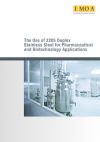Pharmaceutical industry
The pharmaceutical and biotechnology industries provide critical products for society’s healthcare needs. The industry produces a multitude of lifesaving medicines, vaccines and specialized products used in medical testing. The hygienic requirements for this industry sector are very high and the need for product purity mandates that construction materials resist corrosion both in production environments as well as during sanitizing and cleaning procedures.
The surface finish on product-contact surfaces must be smooth to maximize cleanability. This is typically accomplished by electropolishing to a specified surface roughness Ra value. To maintain the highest product integrity, production facilities usually are designed and constructed to meet the requirements of the ASME Bioprocessing Equipment Standard.
Candidate materials of construction must have good weldability and be capable of being electropolished to an Ra reading of 0.38 micro-meters (15 micro-inches) or smoother. Production facilities typically consist of tanks, reaction vessels, tubing and fittings. Molybdenum-containing stainless steels and nickel alloys are used extensively in this industry sector for their improved resistance to localized corrosion in the presence of chloride salts.
Because of its corrosion resistance, weldability, electropolishing properties and availability, Type 316L austenitic stainless steel is the most widely used construction material in pharmaceutical plants. When production environments are too aggressive for Type 316L the industry usually selects a more resistant austenitic stainless steel such as one of the 6% molybdenum super austenitic stainless steels.
Recently the pharmaceutical industry recognized the benefits of duplex stainless steel. The standard grade, 2205 duplex stainless steel, is now used for applications that are too aggressive for Type 316L but don’t need the corrosion resistance of a 6% molybdenum stainless steel. In addition to the lower cost per kilo compared to a 6% molybdenum grade, the increased yield strength of duplex stainless steels can result in higher allowable design stresses and possible cost savings from the reduction in wall thickness. Because of these potential benefits the ASME Bioprocessing Equipment Standard has approved three duplex grades as construction materials. These grades are a lean duplex stainless steel (S32101), 2205 (S32205) and 2507 (S32750).
When pharmaceutical environments are too aggressive for stainless steels the industry uses nickel/chromium/molybdenum alloys. The C276 (N10276) and C22 (06022) alloys are the most common specified alloys for very corrosive environments.
Additional Resources
The Use of 2205 Duplex Stainless Steel for Pharmaceutical and Biotechnology Applications
Sterile stainless steel serves cleanrooms
When studying viruses, making computer chips, or bottling medicines, particles 100 times smaller than a grain of sand can spell disaster. Ultra-sensitive procedures like these take place in cleanrooms, the most meticulously controlled spaces on earth. Type 316 stainless steel is widely used in this sector.


